Rosehip is a wild rose that has served as the starting material for the creation of many varieties of garden roses. The culture is distinguished by its unique attractiveness, beautiful early flowering, and special purpose. Used for garden design, creating hedges, and producing new varieties of roses. The medicinal function of rosehip has been known for a long time and is the main one.
Rosehip, which is found everywhere in temperate countries, came to us from Iran.
Main varieties of rose hips
There are several main types of wild rose known. Based on them, many varieties with different characteristics have been created.
Rose wrinkled
A plant with large leafy, “wrinkled” plates. The wildflower has simple pale pink flowers and a delicate aroma. Terry varieties have been developed that have multi-layer flowers, white, crimson, dark pink, red with a purple tint. For example, the Agnes bush blooms yellow. And the double flowers of “Kaiserin des Nordens” are red with yellowish tint. A unique variety of cloves. Bouquets of small flowers resembling carnations look beautiful against the background of green foliage. Also available in several color options. There is a groundcover varietal variety bred in Canada. With its help, designers design slides and paths.
All varietal varieties of rugosa rose are characterized by long flowering: from late May to August. The bushes are erect, compact, small (up to 1.5 meters).
Wild varieties of rose hips are more frost-resistant than varieties created from them. Hybrids have the least resistance to low temperatures.
Femoral-leaved (thorny) rose
The wild species is a spreading shrub with white, pale yellow flowers and a strong aroma. Flowering is abundant and lasts about three weeks. The fruits are almost black. Has increased frost and drought resistance. Based on the bush, many simple and double varieties have been developed in a variety of colors, including two-color and variegated flowers. The crop is prone to rapid and unlimited production of root shoots. It is difficult to uproot, so it is planted in places where it will not interfere with other trees and shrubs. Used to strengthen slopes. Features of the species: Short flowering, spreading bush, uncontrolled root shoots, dark berries. One of the popular varieties is “Double White”.
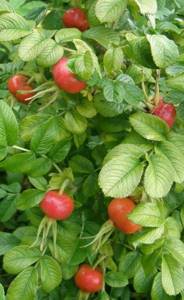
Gray rose (red leaf)
A small compact bush of European origin. Differs in red-brown shoots. The leaf blades are green-gray with a red tint. The shrub blooms with small pink flowers for a short time. Does not produce basal shoots, cold-resistant. Shrubs are used in the design of parks, gardens, and plots. Feature of the species: The branches of the crop are not thorny: small thorns are sparsely located.
Rose brilliant
Rosehip is a native of America. A miniature bush (up to 1 meter high), extremely prickly. The shiny small leaves change their color from green to red with the arrival of the autumn season. The flowers are deep pink, large (diameter up to 5 cm). Flowering begins late compared to domestic species: in June. Carolina rose (low) has similar characteristics. Differs in dull leaves.
Rose is lovely
The culture is widespread on the American continent. The shrub is tall, heavily leafy. The flowers are large and pink. It blooms for a short time: about a month. The bush, which is not picky about care, is used to create hedges from plants.

Dog rose
Tall (up to 3 meters in height), powerful, spreading, thorny shrub. The shape of the spikes is hook-shaped. Heavily leafy bush. Pale pink flowers are not solitary, but are collected in inflorescences. Prone to forming root shoots. It freezes out during severe frosts, but is restored in the spring. Planted as a hedge on the sunny side of the site. It is the basis for selection and grafting of roses. Other types of garden crops are no less attractive. “Shaggy”, “Multifloral” Korean, “Bristlefoot Rose” have similar characteristics.
Rosehip May
Not all representatives of rose hips have pronounced healing characteristics. Medicinal species (more than 30 are known) are used for medical purposes. They have different composition. Cinnamon rosehip (the second name for May rosehip) takes first place in terms of vitamin C content. May rosehip is a shrub that is unpretentious to soil, care, and frost-resistant. In industrial medicine, the berries of the plant (orange, red) are used for the manufacture of pharmacological preparations. The most pronounced properties: antioxidant, vitamin, tonic, wound healing. Strengthens the immune system, speeds up metabolism. Popular hybrids: “Buff Beauty”, “Felicia”, “Penelope”.
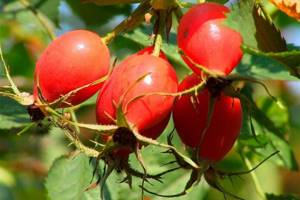
Canine, spiny, and duar species are also used for medicinal purposes. The amount of vitamin C in different varieties varies. Compare: “Vorontsovsky” (3.9 g), “Vitaminny” (3.8 g), “Besshipny” (3.1 g).
Varieties of round rose hips
Among the varieties of rose hips, round berries are considered the most convenient for processing. In addition, such varieties are usually heavier.
Tikhon
A tall variety with thick shoots, abundantly covered with thorns, ripens early. The berries of the plant are round, red-orange, sweet with a noticeable sour taste. The species has good immunity, although it may suffer from anthracnose.

Rosehip variety Tikhon is characterized by high cold resistance
Kolobok
The species with pale pink flowers produces round, red berries. The skin of the fruit is dense, the taste is refreshing with sourness, there is no pronounced aroma. Kolobok can be grown in cold regions; the variety is not afraid of drought.
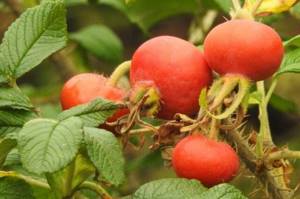
Rosehip Kolobok ripens in the second half of summer
Apple
The low shrub has abundant thorns along the entire length of the shoots. It blooms with beautiful dark red buds, produces large, round, slightly flattened berries. The fruits resemble small apples.
Important! The leaves of the Apple variety are of an unusual color - matte, with a slight bluish tint.

To taste rosehip variety Apple sweet with sour notes
Rosehip classification
According to ripening time
In addition to dividing into types, rose hips are classified according to ripening time.
- Early varieties: harvest in August-September. Variety "Ruby"
- Middle, late: harvested in October. The collection continues until frost. “Ray”, “Large-fruited”.
By region of growth
When choosing a species, zoned varieties are purchased. In the northern regions, early and medium varieties are chosen, with high frost resistance characteristics.
- For planting in the middle zone, the varietal varieties “Crimson” and “Large-fruited” are suitable.
- North-west: “Baikal”, “Ruby”, “Titan”, “Luch”.
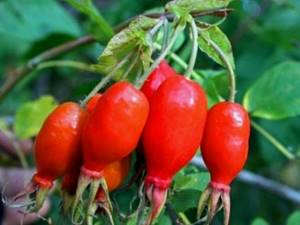
According to the degree of decorativeness
For the design of the garden, the duration of flowering of the crop is important:
- There are known species and varieties whose flowering continues throughout the summer: “Hansa” (wrinkled species).
- Varieties with a short flowering process (up to a month): “Zhon Bicolor”. The process of admiring large orange flowers with a red tint lasts 3 weeks.
According to varietal characteristics
Varietal distinctive features of various representatives. Flower arrangement, its shape: simple - double, carnation (“White Grootendorst”); arranged singly or collected in inflorescences and racemes. Simple: dark pink “Frau Dagmar Hartopp”; double: “Rose yellow” flowers are large, single, double (type “wrinkled”). In the color scheme of flowers: breeding scientists have developed white, red of various shades, yellow, purple. According to the shape and height of the bush:
- Spreading or erect, miniature (“Blanche Moreau” up to 0.8 meters), medium, tall (up to 3 meters).
- Ground cover for decorating borders and paths.
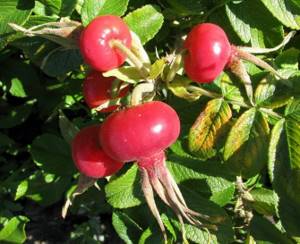
The fruits vary in shape:
- With round berries “Vitaminny VNIVI”, “Globus”, “Apple” (the largest berries).
- Oblong: Variety “Luch”.
- Pear-shaped: "Crimson"
According to the location of the spikes and their shape:
- Thornless: The variety is called “Thornless”. The berries are small.
- Most species have spines. Large, straight or curved thorns, small, frequent, are located along the entire length of the shoot, only at the base, in the fruiting area.
Ornamental plants occupy a special place among all types of crops. They are distinguished by large, sometimes double flowers, and large fruits of unusual color (“Maxima”). Climbing shrubs (“Climbing Iceberg”) are in demand.

The prickly rose hips are often used for garden design. Variety "Alba Mediland" (blooms twice in the summer), "Titan" Wrinkled rosehip is successfully planted instead of a hedge. Varieties "Hanza". Among the domestic varieties, “Queen of the North” has excellent decorative qualities. The variety is adapted to the harsh conditions of the northern regions. For summer residents, we have selected several varieties of rose hips, the best ones created by breeders at this time, with good yield, frost resistance, taste (the taste of the fruits of all examples is sweet and sour), decorative and medicinal qualities.
Popular types of rose hips
If you are planning to grow rose hips on your plot or local area, you should decide on your goals: design of the plot, obtaining a large number of fruits, hedges, etc. To do this, you need to know the characteristics and description of the species, the requirements for growing conditions.
Wrinkly
This species is grown throughout Russia, in the regions of the Far East and Asia, on the North American continent, and in Europe. Feels great on loamy, sandy, clay soil.
Reference! The large shiny dark green leaf plate has many veins, which gave rise to the name of the species.
Compact bushes grow from 80 to 150 cm, erect shoots in adulthood are bare and brown, while when young they are green and pubescent. On shoots with peduncles there are large curved spines with pubescence and small spines.
The serrated leaves (up to 3 cm in length) are round or elliptical, pubescent below, and shiny and wrinkled above.
Fragrant, with a delicate delicate scent, flowers with five or more petals are single or form inflorescences of 3-8 flowers, they are white or different shades of pink. They begin to bloom in early or mid-summer, sometimes blooming throughout the season.
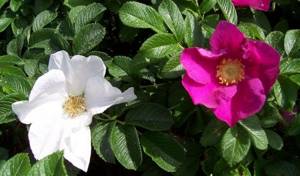
Wrinkled rosehip bushes decorate any area no worse than roses; they are often used to strengthen the soil and as raw materials (leaves, roots, flowers, fruits) in traditional medicine recipes. A hedge made from them looks very beautiful and impressive.
The spherical fruits (3 cm) with fleshy pulp on top are flattened and become orange or red-orange when ripe.
The berries are dried and used to make compotes, preserves, jelly, tea, marmalade, jam, and in traditional medicine recipes.
Advantages of the type:
- without shelter, withstands frosts down to – 40°C;
- can grow in poor soils;
- high immunity to infections and damage by insect pests;
- shoots grow back quickly after pruning;
- reproduces well by seed, root shoots and cuttings;
- the crown is stable - no support is required;
- can grow in one place for 25 years;
- high yield, large, fleshy fruits.
Based on the species, many varieties and hybrid forms with double, semi-double flowers of various colors have been created, and low-growing varieties have been bred.

Varieties of wrinkled rose hips:
- Rrf albo-plena – the color of double flowers is white;
- Rrf plena, Rrf rubroplena – double flowers of various shades of crimson;
- Hansa - unusual flowers with a red-violet color;
- Frau Dagmar Hartopp – low, neat bushes, flowers at the beginning of flowering in dark shades of pink gradually lighten;
- White Grootendorst, Pink Grootendorst, FJ Grootendorst are varieties of carnation roses with small double flowers of white, pink and crimson colors, respectively.
Hybrids are more decorative, but inferior to simple varieties in terms of frost resistance, so simple forms of wrinkled rose hips are more suitable for temperate climates.
Gray (Blue rose, Red-leaved rose)
The species is notable for its tall slender bushes (2 m and above) with burgundy-gray colored foliage, purple shoots and a large number of red fruits.
With a large number of thorns, the shoots are burgundy when young, but when mature they become gray-beige and lose their thorniness. The leaves, like the shoots, change color with age from beetroot to bluish.

The bush looks especially decorative in the fall - the foliage turns orange-yellow or red. Flowers (30-35 mm) of light pink color, shaped like stars, appear in the last ten days of June and bloom for a short time - only two weeks. The red fruits are very bright, beautiful, but inedible.
Rosehip can be planted in areas with cold climates - it tolerates frosty winters well. When planting, it should be taken into account that this species loves bright sunny areas with slight partial shade; in areas with stagnant moisture it grows poorly and may die.
Used in the design of garden plots, as a rootstock for many varieties of roses.
Blue rose hips, varieties:
- f. flore-pleno – double flowers, light shades of pink;
- Carmenetta (hybrid rosehip rugosa) – bright green foliage, pink flowers.
Femoral foliage (spiny, prickly, thin-legged)
The original variety of rose hips has gained popularity due to the bright color of its small leaves, the pleasant smell of creamy white flowers (25-50 mm) and excellent frost resistance. In summer, the bare serrated leaves, consisting of 5-11 leaflets, are dark green above, light green below, and in the fall they turn purple and look beautiful and unusual.

Bushes with straight thorn-covered shoots grow no higher than 2 meters and form a rounded crown. Flowers bloom already in May.
The berries (0.6-1.4 cm) are round or slightly flattened, after ripening they become almost black, edible, and contain a large amount of vitamin C.
Rose hips can be grown almost anywhere - it tolerates frost well, has high immunity to infections and damage from garden pests, and grows on any soil.
Varieties based on femoral rose hips:
- Stanwell Perpetual - cascading shoots, double flowers, pink and white, bloom profusely until frost;
- Golden Wings – the color of the flowers is yellowish-gray;
- Maigold – drooping shoots, yellow flowers with a copper coating;
- Morgenrot - cup-shaped flowers with a white center.
"Vitamin VNIVI"
Spreading shrub. Branches with thorns, except for the area where the fruit cluster is located. The berries are large (weight 4 g), round. With good care, the berry yield is up to 2.5 kg per developed bush. Properties: frost resistance, resistance to fungal and bacterial infections. It has pronounced medicinal characteristics.

Rosehip propagation
There are three known methods for propagating rose hips:
- Using seeds
- Planting seedlings
- Using root layering.
Propagation by seeds
To grow rose hips from seeds, you need to start preparing in the month of August. It is at this time that it will be good to collect the seeds. You need to choose brown fruits that are not yet ripe. This is done because the seed coating does not have time to harden by this time, which means they will be able to germinate with better success.
The planting process itself can be done in spring and autumn, but there are more advantages to doing it in the fall. To propagate rose hips from seeds, you need:
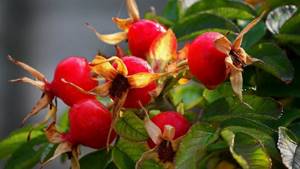
Dog-rose fruit
- When the second month of autumn arrives, the seeds are sown in rows.
- Afterwards they should be fertilized by adding humus and sawdust. The distance must be kept small. It should be such that the hoe or cultivator can work without problems.
- When spring comes, you need to install a frame with a polyethylene tension film. Then the seeds will be able to germinate even better.
- When the first two leaves appear on the sprouts, it will be possible to plant them.
If desired, this procedure can be carried out in the spring, but first you will have to stratify the seeds. To do this, they are mixed with a sand-peat mixture, maintaining a 4:1 ratio, or use river sand. The resulting mixture is placed in a pot before spring arrives and moved to a place with a temperature of 2-3 degrees above zero. In winter, it should be stirred with a spatula from time to time.
Propagation of rose hips by seedlings
Rosehip seedlings will be able to take root more successfully if they are planted in the fall. For example, you can choose October or November for this.
- The hole is dug 20-22 centimeters deep.
- If there is acidic soil, you need to apply fertilizers containing limestone, as well as add manure that has already rotted, and compost.

Rose hips - Before planting the seedlings, they should be trimmed short. After pruning, those branches that are thicker should be no longer than 8-10 centimeters. If you shorten the roots to 15-20 centimeters, the survival rate will improve.
- The roots are placed in a clay mash, straightened and planted in holes so that the neck of the rhizome is 5-8 centimeters below the ground.
- The bush is watered and sprinkled with peat or sawdust on top.
The distance to maintain between seedlings directly depends on the purpose of growing the plant. To create a hedge, they are planted 0.5 meters apart. In order for the bush to bear a lot of fruit, the area must be even more spacious.
Reproduction by root suckers
If you need to leave the characteristics of the mother shrub, the option of propagation by root suckers will be quite suitable. Use those that grow on healthy and fertile bushes. Preparation begins in late autumn or early spring. There are two methods for propagating rose hips by cuttings:
- In spring or autumn, a rosehip branch 25-40 centimeters long is found. Using a shovel, separate from the main bush.

Rosehip in winter - The accessory part is not separated, but from time to time it is hilled up and watered. Thanks to such actions, adventitious roots appear. When autumn comes, a new independent plant is separated, but the rose hips are not replanted until spring comes. Then it will be possible to replant, but carefully so that the root system is not damaged.
"Large-fruited VNIVI"
The bush is tall, spreading, prickly. Branches with a brown tint, up to 2 m long. Blooms with large pink flowers. The fruits are large, round, somewhat flattened; shiny, orange with a red tint. With good care, the berry yield is up to 4 kg per developed bush. Properties: The flowering process is long: from June to October. Frost resistance, resistance to fungal and bacterial infections. It is not used for medical industrial processing due to its low vitamin content.
Why doesn't rose hips bloom?
There are several reasons in total.
Improper care and the appearance of parasites are common. Care includes insufficient water, lack of light, and excessive amounts of fertilizer.
Remember that if the bush was planted this year, it will begin to bloom only next year. Provided that all planting and care rules have been followed.
- To prevent the rose hips from ripening, the shoots are removed annually. This procedure is called pruning. Helps the plant form strong shoots. If you carry out the procedure regularly, then for ten years the rose hips will retain their splendor and beauty.
- This is a drought-resistant plant, so it is rarely watered. If the temperature in the region in which the bush grows reaches thirty degrees, then two buckets of water per day will be enough.

- The amount of feeding depends on several factors. If you want the rosehip to bloom, follow the conditions. After all, both a lack of feeding and an overabundance have a bad effect on it at the same time.
- Nutrients should be applied in the second year after planting. In the spring, once is enough, in the autumn – three. Organic substances are used as fertilizing.
- The plant requires light. Therefore, if the lighting is insufficient, the development of the plant will be inhibited.
- Common pests: aphids and moths. To get rid of them, use onion infusion.
"Ray"
The bush is tall (up to 3 m tall), erect. There are a small number of thorns on the green branches. Basically, the thorns are located at the base of the bush. Blooms pale pink. Red oval berries are large, weighing up to 5 g. Properties: frost resistance, resistance to diseases, pest damage. The ripening process begins in August.
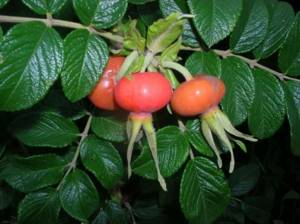
What varieties of rose hips are the most useful?
Of particular interest are cultivated varieties that produce tasty and vitamin-rich fruits. Almost all types have benefits, but a few of them stand out.
Vorontsovsky-3
One of the medicinal varieties of rose hips with good taste ripens in an average time and produces about 2 kg of berries per bush. It blooms with pale pink buds and bears small ovoid fruits in small clusters. The berries of the variety contain up to 4400 mg of ascorbic acid, which makes them very valuable for the immune system.
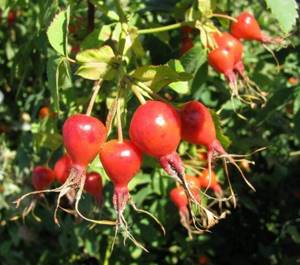
Vorontsovsky-3 has a sweet and sour taste
Rukh
A late-ripening species with pink buds produces elongated orange berries in clusters of two fruits. It is distinguished by its vitamin C content of more than 1020 mg per 100 g. The berries themselves are large, up to 3 g by weight.

Rosehip Rukh requires pollination by related varieties and species
Vitamin VNIVI
A spreading variety of edible rose hips produces large spherical fruits with a sweet and sour taste. From one copy of the plant you can collect up to 3 kg of berries. The pulp contains about 4000 mg of vitamin C, and carotenoids that are beneficial for the body are also present in large quantities.
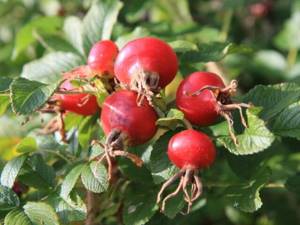
Vitamin VNIVI can grow in the Urals and Siberia
"Titanium"
The bush is tall, erect, powerful. Branches up to 2 m long. Flowers pale pink. The fruits are large. Collected in clusters of 3-5 berries. The taste is sweet and sour. Productivity 1 kg per adult bush. Properties: Blooms profusely and beautifully from mid-August. Tolerates low temperatures well and is resistant to fungal and bacterial infections. Ripens in October. Suitable for designer garden decoration.

Rosehip varieties without thorns
Plant species with smooth shoots or sparse and soft thorns are in high demand. It is much more convenient to harvest from such bushes.
Thornless
A tall variety up to 3 m with pale pink flowers ripens in August. Brings smooth, elongated berries; a bush can yield up to 1.2 kg of yield. Valued for the high content of vitamins C and P in the fruits, as well as for completely smooth shoots.
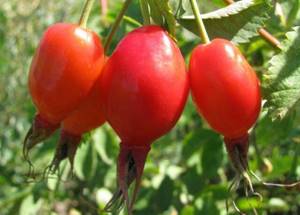
Thornless rosehip requires regular removal of root shoots
Russian-2
A tall variety with large pink buds bears spindle-shaped fruits. The species has thorns, but they are soft, not sharp, and only in the lower part of the shoots. There is no need to worry about scratches when harvesting.
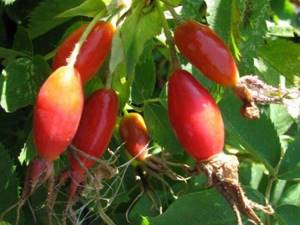
The Russian-2 variety ripens in August
Sergievsky
The Russian variety for the middle zone is distinguished by delicious sweet and sour berries and beautiful pale pink flowers. The thorns are located only at the bottom of the shoots; they are thin, soft and sparse, and do not interfere with harvesting.
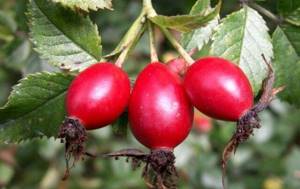
Sergievsky species is resistant to diseases and insects
"Apple"
The bush is low, erect, spreading. Branches up to 1.5 m long, completely covered with thin and straight thorns. The leaf blades are large, gray-blue, pubescent on the inside. The flowers are large, dark red. The fruits are large, up to 12 g in weight, up to 3 cm in diameter; round, slightly flattened, similar to apples. The taste is sweet and sour. When choosing a rosehip seedling for planting on a summer cottage, gardeners are guided, first of all, by the expected result. Are you trying to get a complete medicinal product? Choose from a group of rosehips intended for medicinal use. Are you dreaming of a highlight that will decorate your garden? Choose a plant that blooms and bears fruit beautifully and has distinctive leaves. Hybrids combine these qualities. They are beautiful, productive, and have retained their medicinal properties. But hybrid varieties have lost the frost resistance of wild rose hips and resistance to diseases.
The further a variety is from its wild predecessor, the less cold-resistant it is and the more susceptible to infections.
Article Rating
Rose hip care
Rose hips have a powerful, branched and deep measles system. Therefore, it is watered only in severe drought.
Fertilizer promotes rapid development, abundant flowering and fruiting of rose hips

In order for the beneficial properties of the crop to fully manifest itself, it is fed three times a season. This is done when the buds swell, after the rose hips have faded and the harvest has been harvested. Photo: europa-market.ru
At the same time, 30 g of ammonium nitrate, nitroammophos and 90 g of Effekton organic fertilizer are mixed in a bucket of water. 15 liters of liquid fertilizer is poured under each bush.
Pruning is important for the formation of a healthy and productive bush

Rose hips should be pruned in April or October. Photo: profermu.com
- At the same time, dried, diseased, weakened, damaged and excess shoots are completely removed from the bush.
- Strong branches are pruned to 0.6–1 m.
Medicinal properties and indications for the use of rosehip flowers
Rosehip flowers are the ancestor of all ornamental rose crops. The most common use of rose fruits of the bush. The leaves, roots and petals of wild rose are also used in folk medicine. Rosehip flowers are collected in the spring, when the concentration of nutrients in them is highest. The characteristics of the plant describe it as a perennial shrub, unpretentious and widespread. Rosehip has about 200 species, among which there are dwarf plants and bushes reaching 10 m in height. Fruits, flowers and leaves, collected at a certain time, are dried and stored in a dark and dry place for about 2 years.
The medicinal properties of rosehip flowers are determined by a unique composition, including organic acids, essential and fatty oils, tannins, glycosides, pigments, sugars, minerals, flavonoids, waxes, anthocyanins. Contains a large amount of vitamins: ascorbic acid, B vitamins, retinol, tocopherol, vitamin K and P. Thanks to its rich composition, the plant has a lot of healing properties:
- Antiseptic, anti-inflammatory, bactericidal, antifungal.
- Choleretic.
- Immunostimulating, tonic.
- Emollient.
- Antispasmodic.
- Antisclerotic.
- Enzymatic.
- Diuretic.
- Hypotensive.
- Hemostatic.
- Astringent.
- Regenerating.
The benefits of rosehip flowers are invaluable. It has a positive effect on the walls of blood vessels and capillaries, and stimulates myocardial activity.

Wild rose flowers are indicated as part of a complex treatment for the following diseases.
- Diseases of the digestive system: gastritis, cholecystitis, colitis, ulcerative lesions of the stomach and duodenum, diarrhea, intestinal atony. Use in the acute stage is prohibited.
- Pathologies of the urinary system: pyelonephritis, cystitis, kidney stones and urolithiasis.
- Metabolic disorders: diabetes mellitus, obesity of varying severity and edema caused by excess weight.
- Cardiovascular pathologies: circulatory disorders, atherosclerosis, heart failure, myocarditis, vascular fragility.
- Failures of hematopoietic processes: anemia of various etiologies, malignant blood pathologies. To improve blood clotting during uterine, nasal, and gastrointestinal bleeding.
- Central nervous system disorders: stress, chronic fatigue syndrome, nervous disorders, sleep disorders.
- Diseases of the musculoskeletal system are treated thanks to the plant’s ability to remove salts from the body. It is successfully used for gout and rheumatism to relieve swelling and inflammation of the joints.
- Traumatic injuries to bones and epidermis: wounds, burns, cuts, fractures, bruises, cracks, bedsores.
- Hemorrhoidal fissures: as an antiseptic.
- Dermatological diseases: dermatitis, eczema of various etiologies, psoriasis, erysipelas, trophic ulcers.
- Diseases of the respiratory system: bronchitis, pneumonia, acute respiratory viral infections, tuberculosis.
- Intoxication of the body: alcohol, food, radiation, chemical, due to increased body temperature. Rosehip removes toxins from the body and has an antioxidant effect.
- Decreased immunity caused by vitamin deficiency.
It is important to know that in the form of decoction, compote and herbal tea, rosehip lowers blood pressure, therefore it can be used to treat patients with chronic hypertension. An alcoholic tincture of the bush is indicated only for people with persistent hypotension.
Before starting a therapeutic course with rosehip-based products, you must consult a specialist, as they have contraindications:
- Thrombophlebitis. Rosehip is not used to treat such patients, as it increases blood clotting.
- Diseases of the stomach with high acidity and in the acute stage of pathologies of the digestive system.
- Allergic manifestations and individual intolerance to flowers and fruits of shrubs. In this case, rose hips can harm the body.
- Increased sensitivity of tooth enamel. In this case, it is not recommended to drink rosehip drink or you need to drink it through a special straw.
- Calculous cholecystitis with large stones. In this case, consumption leads to blockage of the bile duct with a stone.
Description of the beneficial properties of the plant
The fruits, flowers, leaves and roots of rose hips are used for medicinal purposes. According to the description, they contain organic acids, minerals, vitamins, carotene, phytoncide, sucrose and essential oils .
They are widely used in folk and modern medicine. The healing parts of rose hips have the following properties:
- cleanse the circulatory system;
- improve metabolic processes;
- strengthen weak immunity;
- the body is enriched with vitamins;
- used for anemia;
- used for kidney and bladder diseases;
- prescribed for liver problems;
- used as a diuretic and tonic.
Rose hips: types and varieties, photos
The variety of wild roses is great. Each rose hip (we will list the types in the article) has its own characteristics. For example, the wrinkled rose is characterized by a long flowering period: from June to autumn. She, like most wild plants of this species, has pink flowers with a pleasant delicate aroma, arranged singly or in small groups.

In addition to this most common form in gardening, there are many others that differ in the height and shape of the bush, the size and shade of the flowers. Nevertheless, all types of decorative rose hips have many similar features. For example, they all have erect bushes that are completely covered with recognizable “wrinkled” leaves. The following types of rose hips are very popular in landscaping (with the photographs presented in the article, it will be easier for you to navigate the varieties of plants): crimson terry variety, white terry, an old form with red-violet large flowers, a low variety with dark pink flowers that lighten with time.
Currently, there are a large number of hybrid forms that are part of the collection of park roses. The most interesting of them is the group of carnation forms. They have small double flowers with jagged petals, collected in dense inflorescences. This group contains raspberry, pink and white varieties.
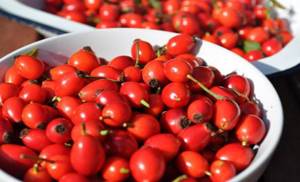
Currently, Canadian hybrids of wrinkled roses have become very popular, among them there are ground cover varieties that are often used to decorate slopes and garden paths. However, one significant nuance should be kept in mind: the more decorative a variety is bred, the less frost-resistant it becomes. It turns out that it is rosehip. The species we previously mentioned (wrinkled rose and its simplest forms) are the least whimsical, and therefore more adapted to various surprises of nature in our latitudes.











